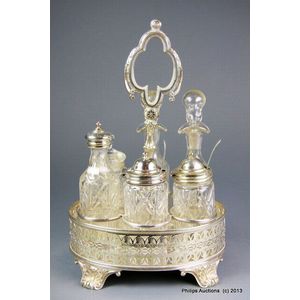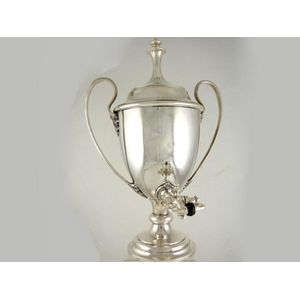Austrian Counterweight Bronze Table Lamp, Circa 1900
You must be a subscriber, and be logged in to view price and dealer details.
Subscribe Now to view actual auction price for this item
When you subscribe, you have the option of setting the currency in which to display prices to $Au, $US, $NZ or Stg.
- Anthemion - An anthemion is a classical decorative design element based on the acanthus flower that consists of a central circular or oval motif surrounded by radiating petals or leaves. It is often used as a border or frieze in architecture, furniture, and other decorative arts. The anthemion is derived from the palmette, a motif that was popular in ancient Greek and Roman art and architecture. It is often associated with the classical world and with Neoclassical style, and it is often used to add a sense of grandeur and formality to a design. The anthemion is also known as a honeysuckle or honeysuckle ornament. It continues to be used in a variety of contexts today, and it is often admired for its elegant and decorative qualities.
- Socle - The short plinth, usually cylindrical, that serves as a pedestal for a sculpture or vase
- Bronze - An alloy of copper and tin, traditionally in the proportions of about 9 parts of copper to 1 part of tin.
The discovery of bronze in Western Asia in the 4th century enabled people to create metal objects which were superior to those previoulsy possible because of its strength and hardness, and it has been used throughout the world for weapons, coins, tools, statuary and other decorative items.
It is very fluid in a molten state, and its hardness, strength when set, and non-corrosive properties makes it most suitable for casting sculpture. - Circa - A Latin term meaning 'about', often used in the antique trade to give an approximate date for the piece, usually considered to be five years on either side of the circa year. Thus, circa 1900 means the piece was made about 1900, probably between 1895 and 1905. The expression is sometimes abbreviated to c.1900.
This item has been included into following indexes:
Visually similar items

A German.835 silver candelabrum, early 20th century, with crescent and Crown mark and maker's mark for Jakob Grimminger, with a pair of cornucopia arms with compressed rims issuing from a knopped spiral twist stem and spreading base, marked to lower foot a

A silver plate and glass cruet set, late 19th to early 20th century, a complete six bottle cut glass cruet set within a silver-plated stand with a pierced Prince of Wales feather-style gallery and upon four shell scroll feet, the central stem with a quatre

An Edwardian plated tea urn with a domed cover, tap and reeded handles in Adams style. Maker: Walker and Hall. 50 cm high

Viners silver plated candelabrum 34 cm high
